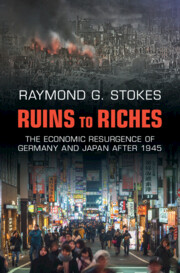Book contents
- Ruins to Riches
- Ruins to Riches
- Copyright page
- Dedication
- Contents
- Charts and Figures
- Acknowledgements
- Introduction
- Part I No Mere Incantation
- Part II Making Miracles, 1950–1973
- 3 Manufacturing Miracles I
- 4 Manufacturing Miracles II
- 5 Consuming Miracles
- 6 Exporting Wonders
- Part III Sustaining Miracles, 1973–1989
- Part IV Navigating Waves of Globalization, 1990 to the Present
- Notes
- Index
5 - Consuming Miracles
from Part II - Making Miracles, 1950–1973
Published online by Cambridge University Press: 12 April 2024
- Ruins to Riches
- Ruins to Riches
- Copyright page
- Dedication
- Contents
- Charts and Figures
- Acknowledgements
- Introduction
- Part I No Mere Incantation
- Part II Making Miracles, 1950–1973
- 3 Manufacturing Miracles I
- 4 Manufacturing Miracles II
- 5 Consuming Miracles
- 6 Exporting Wonders
- Part III Sustaining Miracles, 1973–1989
- Part IV Navigating Waves of Globalization, 1990 to the Present
- Notes
- Index
Summary
Within a few decades following the end of the Second World War, Germany moved from a country of middling wealth per capita to one of the wealthiest countries in the world. In the meantime, the Japanese, very poor indeed in 1945 in spite of a strong showing in terms of industrialisation and technology, joined that select club only about a decade after the Germans. At the same time, Germans and Japanese became in general more economically equal. This is reflected in the rise of consumerism in both countries, and increasingly the nations’ affluent consumers showed no hesitation whatsoever in purchasing domestically manufactured white goods and many other products. In doing so, they helped power the countries’ respective economic miracles. Moreover, their purchases and savings also made the companies that produced the goods more financially secure while at the same time enabling increasing levels of technological capability. This provided a sound basis for those firms to move ever more aggressively into export markets by the end of the first quarter-century after the war’s end. West Germany forged into these export markets earlier than the Japanese, who were less reliant on export for growth.
- Type
- Chapter
- Information
- Ruins to RichesThe Economic Resurgence of Germany and Japan after 1945, pp. 94 - 111Publisher: Cambridge University PressPrint publication year: 2024



